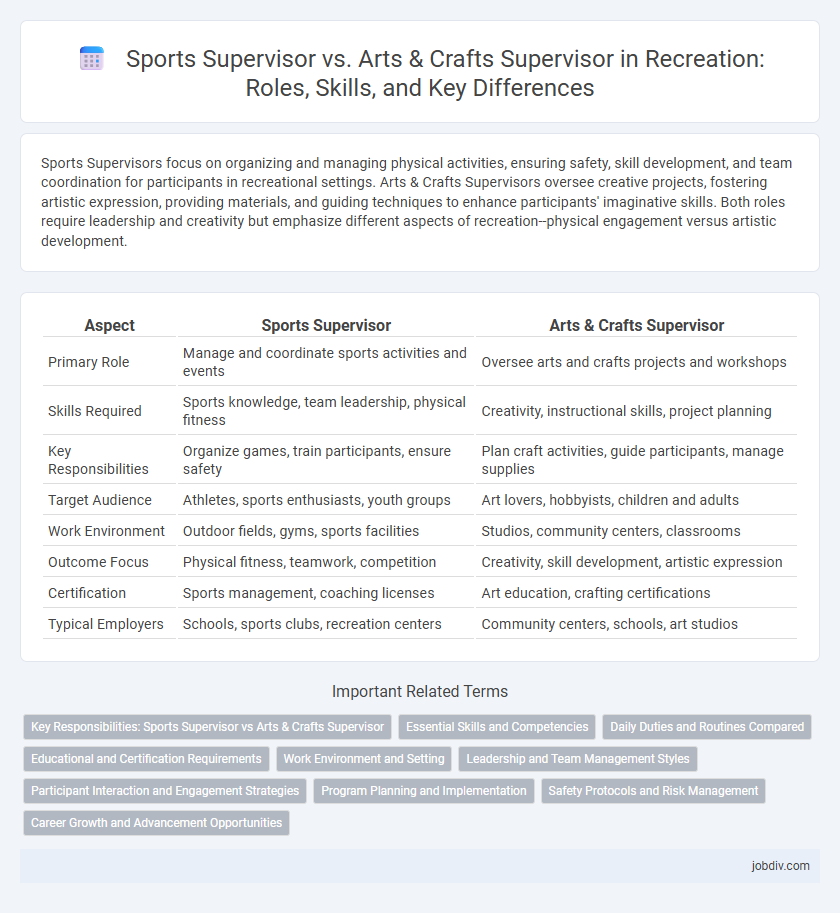Sports Supervisors focus on organizing and managing physical activities, ensuring safety, skill development, and team coordination for participants in recreational settings. Arts & Crafts Supervisors oversee creative projects, fostering artistic expression, providing materials, and guiding techniques to enhance participants' imaginative skills. Both roles require leadership and creativity but emphasize different aspects of recreation--physical engagement versus artistic development.
Table of Comparison
| Aspect | Sports Supervisor | Arts & Crafts Supervisor |
|---|---|---|
| Primary Role | Manage and coordinate sports activities and events | Oversee arts and crafts projects and workshops |
| Skills Required | Sports knowledge, team leadership, physical fitness | Creativity, instructional skills, project planning |
| Key Responsibilities | Organize games, train participants, ensure safety | Plan craft activities, guide participants, manage supplies |
| Target Audience | Athletes, sports enthusiasts, youth groups | Art lovers, hobbyists, children and adults |
| Work Environment | Outdoor fields, gyms, sports facilities | Studios, community centers, classrooms |
| Outcome Focus | Physical fitness, teamwork, competition | Creativity, skill development, artistic expression |
| Certification | Sports management, coaching licenses | Art education, crafting certifications |
| Typical Employers | Schools, sports clubs, recreation centers | Community centers, schools, art studios |
Key Responsibilities: Sports Supervisor vs Arts & Crafts Supervisor
Sports Supervisors manage team practice schedules, enforce safety protocols, and coordinate athletic events to ensure smooth operations. Arts & Crafts Supervisors oversee material procurement, design creative project schedules, and facilitate instructional workshops to foster participant engagement. Both roles require leadership and organizational skills but focus on distinct activity types, emphasizing physical performance or artistic development respectively.
Essential Skills and Competencies
Sports Supervisors require strong leadership, strategic planning, and knowledge of physical fitness principles to effectively manage athletic programs and ensure participant safety. Arts & Crafts Supervisors excel in creativity, instructional skills, and attention to detail to guide diverse artistic activities and foster skill development in various mediums. Both roles demand excellent communication, organization, and the ability to adapt to different group dynamics and individual needs.
Daily Duties and Routines Compared
Sports Supervisors coordinate team practices, organize games, and ensure player safety through equipment checks and rule enforcement. Arts & Crafts Supervisors manage material supplies, guide creative projects, and set up workstations to maintain a clean and inspiring environment. Both roles require scheduling activities, monitoring participant engagement, and resolving conflicts to foster an enjoyable experience.
Educational and Certification Requirements
Sports Supervisors typically require a bachelor's degree in sports management, physical education, or kinesiology, along with certifications such as CPR and first aid, while experience in coaching or athletic training is highly valued. Arts & Crafts Supervisors often hold degrees in art education, recreation, or fine arts and benefit from certifications in art therapy or specialized craft techniques to enhance program effectiveness. Both roles demand strong leadership skills, though the educational focus and certification needs differ to align with the specific recreational discipline.
Work Environment and Setting
Sports Supervisors typically work in dynamic outdoor settings such as sports fields, gyms, and recreation centers, where they oversee athletic activities and ensure safety protocols. Arts & Crafts Supervisors are often based in indoor environments like community centers, schools, or art studios, managing creative projects and facilitating artistic expression. Both roles require adaptability, but Sports Supervisors operate in more physically active, fast-paced surroundings, while Arts & Crafts Supervisors focus on quieter, structured indoor settings.
Leadership and Team Management Styles
Sports Supervisors demonstrate dynamic leadership by fostering teamwork through goal-oriented coaching and performance monitoring, emphasizing motivation and discipline to enhance athletic outcomes. Arts & Crafts Supervisors adopt a collaborative leadership style that encourages creativity and individual expression, focusing on nurturing talents and facilitating open communication within diverse groups. Both roles require adaptability in managing varying team dynamics but differ in balancing structure versus creative freedom to optimize participant engagement.
Participant Interaction and Engagement Strategies
Sports Supervisors enhance participant interaction by organizing dynamic team activities and fostering competitive yet inclusive environments, utilizing motivational techniques tailored to varied skill levels. Arts & Crafts Supervisors engage participants through creative expression, offering individualized guidance and encouraging collaborative projects that stimulate imagination and social bonding. Both roles prioritize active involvement and personalized support but differ in their focus on physical activity versus artistic development to maximize participant engagement.
Program Planning and Implementation
Sports Supervisors excel in designing dynamic athletic programs emphasizing physical fitness, skill development, and team coordination, ensuring tailored activities meet participants' age and skill levels. Arts & Crafts Supervisors focus on curating creative workshops that promote artistic expression and fine motor skills, sourcing materials and structuring sessions to foster individual creativity and group collaboration. Both roles require strategic program planning and effective implementation, but Sports Supervisors prioritize physical engagement while Arts & Crafts Supervisors emphasize artistic development.
Safety Protocols and Risk Management
Sports Supervisors implement rigorous safety protocols such as proper equipment checks, emergency action plans, and athlete conditioning to minimize injury risks during physical activities. Arts & Crafts Supervisors focus on managing risks related to hazardous materials, including non-toxic supplies, proper ventilation, and supervised tool usage to prevent accidents. Both roles require comprehensive risk assessments and ongoing staff training to ensure participant safety and regulatory compliance.
Career Growth and Advancement Opportunities
Sports Supervisors typically experience faster career growth due to the high demand for organized athletic programs in schools, community centers, and professional sports organizations. Arts & Crafts Supervisors often advance through specialized skill development and expanding into educational or therapeutic art programs, which may offer slower but steady opportunities. Both roles provide leadership pathways, yet Sports Supervisors generally benefit from a broader range of advancement opportunities in competitive, high-visibility environments.
Sports Supervisor vs Arts & Crafts Supervisor Infographic

 jobdiv.com
jobdiv.com